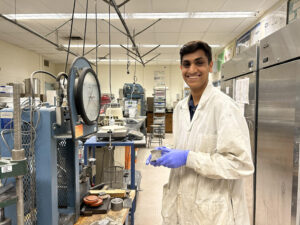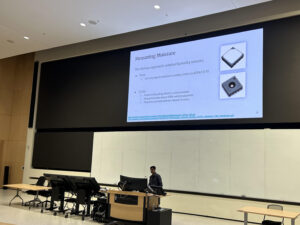Undergrad summer student research positions explored
The following is part of a series introducing CivMin’s undergraduate summer students to the Department and our greater community.
We explore the students’ projects, motivation and challenges, while providing insights into who they are, and what motivates them, beyond academia. It also highlights the multitude of ways summer research opportunities are approached and implemented under the guidance of our industry-leading CivMin professors.

Sheen Patel (CivE, Year 3) has always been interested in concrete. He started exploring this research area in his first year when he joined U of T’s Concrete Toboggan Team. This summer, he’s collaborating with EXACT Technology to develop a concrete sensor which will identify moisture levels at different depths over time, under the supervision of Professor Doug Hooton. His contribution to this project brings it one step closer to creating a user-friendly version of this device to be used by industry.
Tell us a bit about yourself.
Sheen Patel: I’m a Civil Engineering student going into my third year. I’m from Boston and live in Toronto now. I’m working with Professor Doug Hooton on embedding moisture sensors into concrete to track moisture content over time at different depths.
What will be your role this summer and where? What types of tasks and work will you be doing? What’s the research goal?
Sheen: I’m mainly in GB316, GB322 [The Concrete Materials Laboratories] and the Structural Testing Facilities [Sandford-Fleming side]. GB316 and GB322 are more materials-focused labs. There’s a lot of work with smaller bits of concrete, like mortar cubes, and there are some strength-testing machines and resistivity machines, which measure the electrical resistance of concrete. The Structural Testing Facilities involve more large-scale testing machines.
I work on my own project with the moisture sensors and also help some grad students. I’ve been working with embedded electronics and casting concrete. Most of my tasks involve casting mortar cubes, pozzolan material and helping students prepare aggregates. I’ve also been doing compressive strength and bulk resistivity tests. Compressive strength tests involve squeezing the concrete until it breaks, and bulk resistivity tests involve passing electricity through the concrete.
Could you expand on the project you’re working on with the moisture sensors?
The goal of the project [done in collaboration with EXACT Technology] is to find a relationship between impedance [a measure of the opposition to electrical flow] and the humidity/moisture content of concrete, which can be measured with probes and sensors. In the concrete flooring industry, sealants are often put down after the concrete is cast and concrete must have a certain moisture content to ensure the sealant doesn’t destroy it. Usually, you must wait 28 to 30 days [after the concrete is cast to apply the sealant]. If you can measure the moisture to determine exactly when it’s ready, you can save days, which saves a lot of money for construction projects.
It’s fun working with an industry partner because they have very different goals, working styles and working paces.
What’s it been like collaborating with EXACT Technology on this project?
Sheen: I’ve been to EXACT Technology’s office a couple of times. They’re located in Toronto. It’s fun working with an industry partner because they have very different goals, working styles and working paces. The research labs are a bit more relaxed, and the products are part of longer-term projects. It’s been interesting seeing different perspectives – industry versus academic research.
EXACT Technology is developing the electronics and software. So, the visits have involved a lot of working on the electronic side, trying to understand how it functions and how it can be improved. We’re collaboratively testing it to ensure it’s working as intended.
What motivated you to work with Prof. Doug Hooton on this project?
Sheen: Well, I’ve always been interested in concrete. I joined the Concrete Toboggan Team in my first year and did a lot of work on the concrete side of it – making the skis and testing the mix for the bottom of the toboggan. Each year, we develop a new mix, and it needs to be tested. I got involved with that. In my second year, we took a materials course [CIV209 – Civil Engineering Materials], and I learned more about the concrete specifics, including how things interact, and just found it really fun.
Concrete is a fun material, very complex. A lot of people don’t realize how much there is, how many parts there are and how much everything varies. It’s also fun to work in the labs – fiddling with things, testing things and doing the hands-on stuff. I reached out to Prof. Hooton for a summer research opportunity. I liked the project; it sounded fun.

What do you foresee being your greatest challenge?
Sheen: I think my greatest challenge has been understanding the electronics and sensing portion of the project. I essentially restarted the project this year after it had been delayed over COVID. There were limited previous samples and work to go off. I had to figure out how the sensors work, and the math behind them, and gain a better understanding of the general electronics a bit more to do a good job with the project.
There was a lot of trial and error and a lot of research. I read plenty of electronic papers and watched many YouTube videos on how all the electronic stuff works. We don’t take circuits in Civil Engineering, so I had a lot to learn about them for this project.
Have you found any favourite spots on campus?
Sheen: I’ve mainly been in the labs, but they’re really fun to be in. The tables are just covered in cool and interesting stuff.
Do you have any interesting hobbies or talents you’d like to share?
Sheen: I’ve been really enjoying cooking. During the school year, I’m much busier. A lot is going on with classes and clubs. This summer, I’ve taken the time to relax more, and I’ve learned how to cook better. I’ve also been running again. I made it to almost 14 km the other day. Maybe I’ll do a half marathon eventually.
Is there anything I haven’t asked you about you’d like to speak on? Final thoughts?
Sheen: I’ve been having a great time this summer. It’s been fun. It’s more relaxed than school or academics.
Questions for Prof. Doug Hooton:
What do you hope for Sheen to achieve this summer? Any major takeaways?
Prof. Doug Hooton: We wanted to update the work we started a couple of years ago on sensors and concrete. I wanted Sheen to understand the concepts, write up how to log data and analyze the data from that. He seems to have done it. We’re hoping to develop a sensor for industry to improve the prediction of when concrete is suitable for applying finishes. Currently, you have to wait a pre-determined amount of time, which varies by type of concrete and ambient conditions. The sensors will alert the user when the necessary moisture levels have actually been achieved.

How will Sheen be contributing to this project/your research?
Prof. Hooton: From Sheen’s work on the sensor project, we hope we can develop a more user-friendly version of the sensor. We’ve had several students who’ve worked on it in the past. It’s really about keeping it moving, moving it forward. There’s a need for this type of sensor and there’s a lot of movement in the construction industry to adopt sensors for predicting concrete performance. Sheen was also doing other tasks in the lab this summer. He did some research for me on evaluating pozzolans in concrete, and he did some exploratory testing which was very useful, and he did quite well.
I like to hire summer students because I think it sparks an interest in what’s going on in the concrete industry and increases their contact with potential employers.
Is there anything I haven’t asked you about you’d like to speak on? Final thoughts?
Prof. Hooton: I like to hire summer students because I think it sparks an interest in what’s going on in the concrete industry and increases their contact with potential employers. Sheen has directly interacted with EXACT Technology, who are cooperating in this sensor project. He’s been to their offices to look at their sensors. It’s given him some industrial experience. I like the students to get that. In previous years, I’ve had students working with me to cast concrete at plants and other locations. I hope it’s interesting for them too and opens some doors for the future.
Do you have any interesting hobbies or talents you’d like to share?
Prof. Hooton: I do a lot of handyman stuff, a lot of carpentry and repairs. My summer place is about 80 years old and there’s always work to do. It’s an old wooden fishing lodge. We’ve been doing some renovations on it.